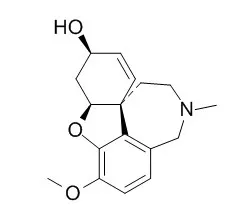| In vivo: |
| Neurotoxicology. 2014 Sep;44:270-8. | | Galantamine prevents long-lasting suppression of excitatory synaptic transmission in CA1 pyramidal neurons of soman-challenged guinea pigs.[Pubmed: 25064080] | Galantamine, a drug currently approved for the treatment of Alzheimer's disease, has recently emerged as an effective pretreatment against the acute toxicity and delayed cognitive deficits induced by organophosphorus (OP) nerve agents, including soman. Since cognitive deficits can result from impaired glutamatergic transmission in the hippocampus, the present study was designed to test the hypothesis that hippocampal glutamatergic transmission declines following an acute exposure to soman and that this effect can be prevented by Galantamine.
METHODS AND RESULTS:
To test this hypothesis, spontaneous excitatory postsynaptic currents (EPSCs) were recorded from CA1 pyramidal neurons in hippocampal slices obtained at 1h, 24h, or 6-9 days after guinea pigs were injected with: (i) 1×LD50 soman (26.3μg/kg, s.c.); (ii) Galantamine (8mg/kg, i.m.) followed 30min later by 1×LD50 soman, (iii) Galantamine (8mg/kg, i.m.), or (iv) saline (0.5ml/kg, i.m.). In soman-injected guinea pigs that were not pretreated with Galantamine, the frequency of EPSCs was significantly lower than that recorded from saline-injected animals. There was no correlation between the severity of soman-induced acute toxicity and the magnitude of soman-induced reduction of EPSC frequency. Pretreatment with Galantamine prevented the reduction of EPSC frequency observed at 6-9 days after the soman challenge.
CONCLUSIONS:
Prevention of soman-induced long-lasting reduction of hippocampal glutamatergic synaptic transmission may be an important determinant of the ability of Galantamine to counter cognitive deficits that develop long after an acute exposure to the nerve agent. | | Acta Neurol Scand. 2014 Jun;129(6):382-92. | | Galantamine treatment in outpatients with mild Alzheimer's disease.[Pubmed: 24461047] | To assess long-term effectiveness of Galantamine in community-dwelling persons with mild Alzheimer's disease.
METHODS AND RESULTS:
Prospective open-label trial including patients with mild AD (NINCDS-ADRDA criteria) treated with Galantamine for up to 36 months. Outcome parameters included ADAS-cog/11, Bayer-ADL scale (self- and caregivers' ratings), 10-item NPI and CGI-change, safety and tolerability measures. Data are presented based on ITT analyses (LOCF).
Seventy-five patients (55% women; mean ADAS-cog 22.3; mean age 70.2 years) were treated with Galantamine for approximately 36 months. About 60% (n=45) received a total daily dose of 24 mg Galantamine at final visit. After 3, 6, and 12 months of treatment, mean improvements in ADAS-cog ranged between 2.2 and 3.0 points (all P<0.05). After 24-month treatment, ADAS-cog returned to baseline value and at 3-year follow-up, patient deteriorated on average by 2.9 points. There was significant improvement on the NPI scale between baseline and 3- to 12-month follow-up (all P<0.05) and at 3-year endpoint, a slight deterioration was noted. Activities of daily living (B-ADL) decreased significantly after 24 months in self-ratings and after 12 months in caregivers' ratings. Fifty-four patients reported at least one AE, most of them occurring during the first 2 years of treatment. Among the most frequently (>10%) reported AEs irrespective of causal relationship to study medication were nausea (17.3%), dizziness (12%), and vomiting (10.7%).
CONCLUSIONS:
Galantamine was generally safe and well tolerated during the 3-year observation period. Cognition, behavior, and activities of daily living improved during 12 months treatment. At 3-year follow-up, worsening in all outcomes was measured; however, cognition remained improved compared with an untreated population. | | Invert Neurosci. 2014 Sep;14(2):91-101. | | Galantamine reverses scopolamine-induced behavioral alterations in Dugesia tigrina.[Pubmed: 24402079] |
METHODS AND RESULTS:
In planaria (Dugesia tigrina), scopolamine, a nonselective muscarinic receptor antagonist, induced distinct behaviors of attenuated motility and C-like hyperactivity. Planarian locomotor velocity (pLMV) displayed a dose-dependent negative correlation with scopolamine concentrations from 0.001 to 1.0 mM, and a further increase in scopolamine concentration to 2.25 mM did not further decrease pLMV. Planarian hyperactivity counts was dose-dependently increased following pretreatment with scopolamine concentrations from 0.001 to 0.5 mM and then decreased for scopolamine concentrations ≥ 1 mM. Planarian learning and memory investigated using classical Pavlovian conditioning experiments demonstrated that scopolamine (1 mM) negatively influenced associative learning indicated by a significant decrease in % positive behaviors from 86 % (control) to 14 % (1 mM scopolamine) and similarly altered memory retention, which is indicated by a decrease in % positive behaviors from 69 % (control) to 27 % (1 mM scopolamine). Galantamine demonstrated a complex behavior in planarian motility experiments since co-application of low concentrations of Galantamine (0.001 and 0.01 mM) protected planaria against 1 mM scopolamine-induced motility impairments; however, pLMV was significantly decreased when planaria were tested in the presence of 0.1 mM Galantamine alone. Effects of co-treatment of scopolamine and Galantamine on memory retention in planaria via classical Pavlovian conditioning experiments showed that Galantamine (0.01 mM) partially reversed scopolamine (1 mM)-induced memory deficits in planaria as the % positive behaviors increased from 27 to 63 %.
CONCLUSIONS:
The results demonstrate, for the first time in planaria, scopolamine's effects in causing learning and memory impairments and Galantamine's ability in reversing scopolamine-induced memory impairments. | | Addict Biol. 2014 Jan;19(1):1-4. | | Galantamine attenuates reinstatement of cue-induced methamphetamine-seeking behavior in mice.[Pubmed: 22260318] | Methamphetamine (METH) dependence is becoming a serious socioeconomic health problem worldwide. The enhancement of the cholinergic nervous system is expected to greatly alleviate drug dependence.
METHODS AND RESULTS:
We investigated the effect of Galantamine on the reinstatement of cue-induced METH-seeking behavior using a self-administration experiment. Treatment with Galantamine (1 mg/kg, p.o.) 30 minutes before exposure to the cues suppressed the reinstatement of METH-seeking behavior. However, Galantamine did not affect the cue-induced reinstatement of food-seeking behavior or locomotor activity.
CONCLUSIONS:
These results suggest that Galantamine may be a candidate drug for treating relapses of METH-seeking behavior. |
|






 Cell. 2018 Jan 11;172(1-2):249-261.e12. doi: 10.1016/j.cell.2017.12.019.IF=36.216(2019)
Cell. 2018 Jan 11;172(1-2):249-261.e12. doi: 10.1016/j.cell.2017.12.019.IF=36.216(2019) Cell Metab. 2020 Mar 3;31(3):534-548.e5. doi: 10.1016/j.cmet.2020.01.002.IF=22.415(2019)
Cell Metab. 2020 Mar 3;31(3):534-548.e5. doi: 10.1016/j.cmet.2020.01.002.IF=22.415(2019) Mol Cell. 2017 Nov 16;68(4):673-685.e6. doi: 10.1016/j.molcel.2017.10.022.IF=14.548(2019)
Mol Cell. 2017 Nov 16;68(4):673-685.e6. doi: 10.1016/j.molcel.2017.10.022.IF=14.548(2019)